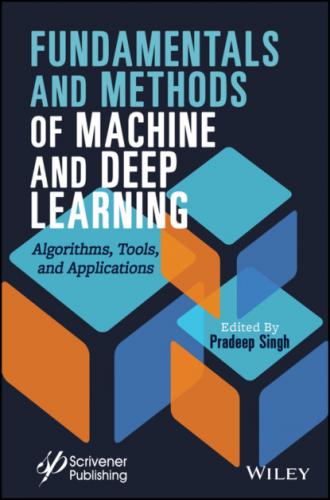Library of Congress Cataloging-in-Publication Data
ISBN 978-1-119-82125-0
Cover image: Pixabay.Com
Cover design by Russell Richardson
Set in size of 11pt and Minion Pro by Manila Typesetting Company, Makati, Philippines
Printed in the USA
10 9 8 7 6 5 4 3 2 1
Preface
Over the past two decades, the field of machine learning and its subfield deep learning have played a main role in software applications development. Also, in recent research studies, they are regarded as one of the disruptive technologies that will transform our future life, business and the global economy. The recent explosion of digital data in a wide variety of domains, including science, engineering, internet of things, biomedical, healthcare and many business sectors, has declared the era of big data, which cannot be analyzed by classical statistics but by the more modern, robust machine learning and deep learning techniques. Since machine learning learns from data rather than by programming hard-coded decision rules, an attempt is being made to use machine learning to make computers that are able to solve problems like human experts in the field.
The goal of this book is to present a practical approach by explaining the concepts of machine learning and deep learning algorithms with applications. Supervised machine learning algorithms, ensemble machine learning algorithms, feature selection, deep learning techniques, and their applications are discussed. Also included in the eighteen chapters is unique information which provides a clear understanding of concepts by using algorithms and case studies illustrated with applications of machine learning and deep learning in different domains, including disease prediction, software defect prediction, online television analysis, medical image processing, etc. Each of the chapters briefly described below provides both a chosen approach and its implementation.
Chapter 1 assists in learning supervised machine learning algorithms and their applications.
Chapter 2 discusses the detection of zonotic diseases using ensemble machine learning algorithms.
Chapter 3 provides machine learning model evaluation techniques.
Chapter 4 analyzes MSEIR and LSTM models for the prediction of COVID-19 using RMSLE.
Chapter 5 discusses the significance of feature selection techniques in machine learning.
Chapter 6 provides insight into the development of disease prediction systems using machine learning and deep learning.
Chapter 7 discusses the detection of diabetic retinopathy using ensemble learning techniques.
Chapter 8 presents a case study for medical analysis of heart disease using machine learning and deep learning.
Chapter 9 discusses a novel convolutional neural network model to predict software defects.
Chapter 10 familiarizes the reader with the process of predictive analysis on online television videos using machine learning algorithms.
Chapter 11 discusses a combinational deep learning approach to visually evoked EEG-based image classification.
Chapter 12 gives a comparative analysis of machine learning algorithms with balancing techniques for credit card fraud detection.
Chapter 13 describes crack detection in civil structures using deep learning.
Chapter 14 discusses measuring urban sprawl using machine learning.
Chapter 15 is all about the applications of deep learning algorithms in medical image processing.
Chapter 16 assists in understanding the simulation of self-driving cars based on deep learning.
Chapter 17 discusses assistive technologies for visual hearing and speech impairments using machine learning and deep learning solutions.
Chapter 18 provides insight into the role of deep learning in remote sensing.
Finally, I would like to express my heartfelt thanks to all authors, reviewers, and the team at Scrivener Publishing for their kind co-operation extended during the various stages of processing this book.
Pradeep Singh November 2021
1
Supervised Machine Learning: Algorithms and Applications
Shruthi H. Shetty*, Sumiksha Shetty†, Chandra Singh‡ and Ashwath Rao§
Department of ECE, Sahyadri College of Engineering & Management, Adyar, India
Abstract
The fundamental goal of machine learning (ML) is to inculcate computers to use data or former practice to resolve a specified problem. Artificial intelligence has given us incredible web search, self-driving vehicles, practical speech affirmation, and a massively better cognizance of human genetic data. An exact range of effective programs of ML already exist, which comprises classifiers to swot e-mail messages to study that allows distinguishing between unsolicited mail and non-spam messages. ML can be implemented as class analysis over supervised, unsupervised, and reinforcement learning. Supervised ML (SML) is the subordinate branch of ML and habitually counts on a domain skilled expert who “teaches” the learning scheme with required supervision. It also generates a task that maps inputs to chosen outputs. SML is genuinely normal in characterization issues since the aim is to get the computer, familiar with created descriptive framework. The data annotation is termed as a training set and the testing set as unannotated data. When annotations are discrete in the value, they are called class labels and continuous numerical annotations as continuous target values. The objective of SML is to form a compact prototype of the distribution of class labels in terms of predictor types. The resultant classifier is then used to designate class labels to the testing sets where the estimations of the predictor types are known, yet the values of the class labels are unidentified. Under certain assumptions, the larger the size of the training set, the better the expectations on the test set. This motivates the requirement for numerous area specialists or even different non-specialists giving names to preparing the framework. SML problems are grouped into classification and regression.
